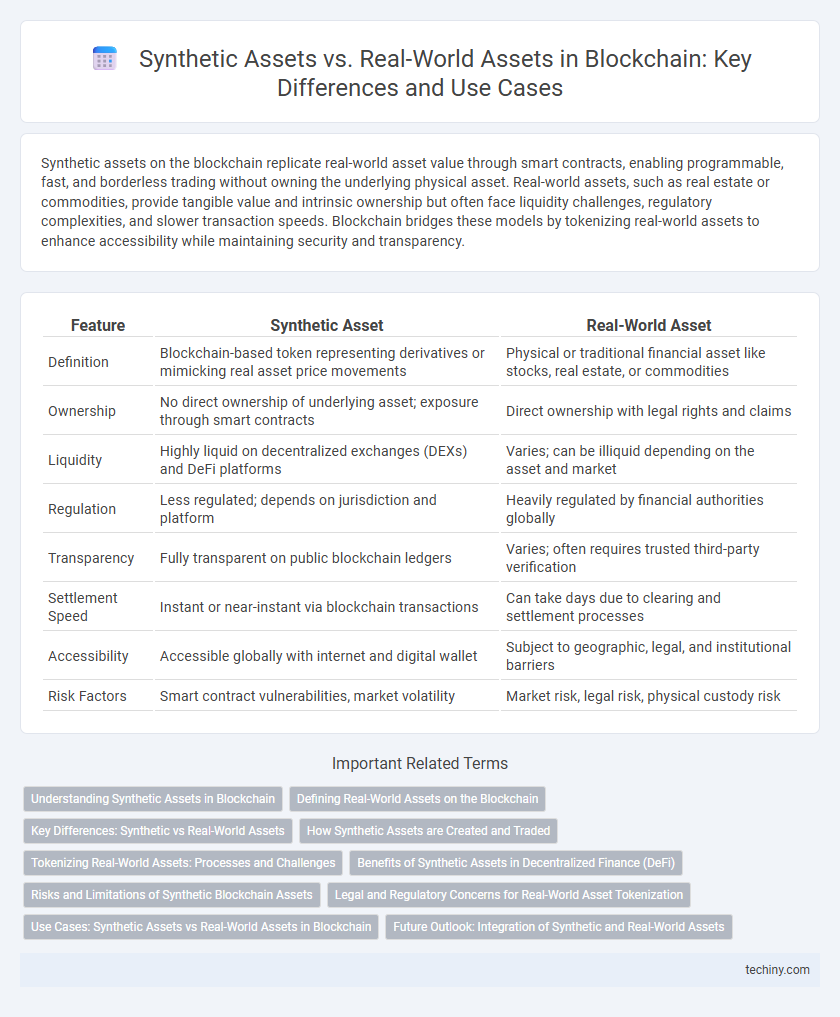Synthetic assets on the blockchain replicate real-world asset value through smart contracts, enabling programmable, fast, and borderless trading without owning the underlying physical asset. Real-world assets, such as real estate or commodities, provide tangible value and intrinsic ownership but often face liquidity challenges, regulatory complexities, and slower transaction speeds. Blockchain bridges these models by tokenizing real-world assets to enhance accessibility while maintaining security and transparency.
Table of Comparison
| Feature | Synthetic Asset | Real-World Asset |
|---|---|---|
| Definition | Blockchain-based token representing derivatives or mimicking real asset price movements | Physical or traditional financial asset like stocks, real estate, or commodities |
| Ownership | No direct ownership of underlying asset; exposure through smart contracts | Direct ownership with legal rights and claims |
| Liquidity | Highly liquid on decentralized exchanges (DEXs) and DeFi platforms | Varies; can be illiquid depending on the asset and market |
| Regulation | Less regulated; depends on jurisdiction and platform | Heavily regulated by financial authorities globally |
| Transparency | Fully transparent on public blockchain ledgers | Varies; often requires trusted third-party verification |
| Settlement Speed | Instant or near-instant via blockchain transactions | Can take days due to clearing and settlement processes |
| Accessibility | Accessible globally with internet and digital wallet | Subject to geographic, legal, and institutional barriers |
| Risk Factors | Smart contract vulnerabilities, market volatility | Market risk, legal risk, physical custody risk |
Understanding Synthetic Assets in Blockchain
Synthetic assets in blockchain are digital representations of real-world assets created through smart contracts, enabling fractional ownership and enhanced liquidity without the need to hold the underlying asset. These assets track the price movements of commodities, stocks, or cryptocurrencies using decentralized oracles to ensure accurate market data. By eliminating intermediaries and enabling programmable ownership, synthetic assets facilitate seamless trading and hedging opportunities within decentralized finance ecosystems.
Defining Real-World Assets on the Blockchain
Real-world assets on the blockchain represent tangible or financial assets such as real estate, commodities, or company shares digitally tokenized to enable secure, transparent ownership and transfer. These tokenized assets provide on-chain liquidity, bridging the gap between traditional financial markets and decentralized finance (DeFi) ecosystems. Blockchain oracles and legal frameworks ensure accurate asset representation, compliance, and enforceability in digital form.
Key Differences: Synthetic vs Real-World Assets
Synthetic assets are blockchain-based tokens that replicate the value of real-world assets without requiring ownership of the underlying asset, enabling fractional ownership and 24/7 trading on decentralized platforms. Real-world assets such as real estate, commodities, or stocks represent physical or tangible items traded on traditional financial markets with regulatory oversight and settlement processes. Synthetic assets offer enhanced liquidity, lower entry barriers, and programmability through smart contracts, while real-world assets provide tangible value and intrinsic stability backed by physical existence or legal rights.
How Synthetic Assets are Created and Traded
Synthetic assets are created through smart contracts on blockchain platforms, using collateralized debt positions or algorithmic protocols to mirror the value of real-world assets such as stocks, commodities, or fiat currencies. Traders can buy, sell, and leverage synthetic assets on decentralized exchanges (DEXs) without needing to own the underlying asset, enabling fractional ownership and increased liquidity. The transparency and programmability of blockchain facilitate real-time settlement and reduce counterparty risk compared to traditional financial systems.
Tokenizing Real-World Assets: Processes and Challenges
Tokenizing real-world assets involves creating blockchain-based digital representations of physical items like real estate, commodities, or art, enabling increased liquidity and fractional ownership. The process requires rigorous asset verification, legal compliance, and secure smart contract development to ensure authenticity and enforceability. Challenges include navigating complex regulatory frameworks, ensuring accurate asset valuation, and maintaining transparency to build investor trust in synthetic tokens mirroring real-world value.
Benefits of Synthetic Assets in Decentralized Finance (DeFi)
Synthetic assets in decentralized finance (DeFi) offer unparalleled accessibility by enabling users to gain exposure to real-world asset price movements without holding the underlying instruments, reducing entry barriers and increasing liquidity. These assets provide enhanced composability within blockchain ecosystems, allowing seamless integration with smart contracts and DeFi protocols, facilitating automated trading strategies and yield generation. Furthermore, synthetic assets eliminate the need for intermediaries, lowering transaction costs and improving transparency through immutable blockchain records.
Risks and Limitations of Synthetic Blockchain Assets
Synthetic blockchain assets expose investors to smart contract vulnerabilities and potential oracle manipulation, which can lead to inaccurate asset valuations or losses. Regulatory uncertainties and lack of clear legal frameworks increase the risk of compliance issues and market restrictions. Moreover, synthetic assets often suffer from lower liquidity and higher volatility compared to real-world assets, complicating price stability and market trust.
Legal and Regulatory Concerns for Real-World Asset Tokenization
Real-world asset tokenization faces complex legal and regulatory challenges including compliance with securities laws, anti-money laundering (AML) regulations, and property rights verification. Jurisdictional differences create uncertainty over asset classification, custody, and transferability, complicating investor protections and dispute resolution. Ongoing regulatory frameworks aim to balance innovation with safeguarding market integrity, requiring token issuers to maintain transparency and adhere to strict compliance standards.
Use Cases: Synthetic Assets vs Real-World Assets in Blockchain
Synthetic assets on blockchain enable fractional ownership, increased liquidity, and 24/7 trading of otherwise illiquid real-world assets like stocks, commodities, and real estate. Real-world assets tokenized on-chain provide direct exposure and verifiable ownership, enhancing transparency and reducing intermediaries in asset management and transfer. Use cases in decentralized finance (DeFi) emphasize synthetic assets for derivatives trading and hedging, while tokenized real-world assets facilitate compliance, cross-border transactions, and asset-backed lending.
Future Outlook: Integration of Synthetic and Real-World Assets
The future outlook of blockchain emphasizes the seamless integration of synthetic assets with real-world assets, enabling enhanced liquidity and accessibility across financial markets. Platforms leveraging decentralized finance (DeFi) protocols aim to bridge the gap by tokenizing tangible assets, providing users with programmable and fractional ownership. This fusion is expected to drive innovation in asset management, reduce barriers to entry, and foster a more inclusive global financial ecosystem.
synthetic asset vs real-world asset Infographic

 techiny.com
techiny.com